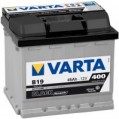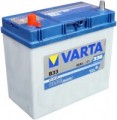Standard
The form factor describes the general design features of the battery, primarily the way the terminals are installed and their dimensions, as well as the dimensions of the battery itself.
—
European. A distinctive feature of European batteries are the terminals, somewhat recessed into the case. Due to this, this form factor is considered safer than the Asian form factor — the risk of a short circuit is lower when the battery falls on a conductive surface or when a metal object hits it. In addition, the terminals themselves are usually made in the form of Euro cones (see below for more details). As for the dimensions, European batteries have more depth and less height than Asian ones. As the name implies, this form factor is found in cars of European manufacturers, mainly passenger cars.
—
Asian. Asian batteries are easy to identify by the terminals protruding from the top of the case; also, these terminals can be noticeably thinner than European ones, because. many models use JAP cones (although not all). If compared in size, then the "Asians" are taller and thinner than the "Europeans" (more precisely, they have less depth). This option is popular with Japanese and Korean automakers, and is also quite widespread among trucks.
— American. A rather rare form factor on our roads — due to the fact that cars from American manufacturers are most often delivered to us in the form
...of modifications adapted to Europe or Asia; original versions are rare. Lightweight batteries of this form factor have "USA" screw terminals (see "Terminals"), located not on the cover, but on the front wall of the case. At the same time, both “purely American” and combined batteries are produced, which, in addition to a pair of USA terminals on the front wall, also have contacts on the cover that are more familiar to east european drivers. And in cargo batteries of this form factor, the terminals are usually installed on the cover, in the left side location.
When choosing a battery, it makes sense to clarify which form factor is optimal for your car: a discrepancy in this parameter can cause compatibility problems up to the complete impossibility of installing a battery.Terminals
Battery terminal design. First of all, compatibility with a particular car model depends on this parameter - different automakers use different battery connection systems. Note that some types of terminals can work with "non-native" wires; however, such a connection has a number of "pitfalls", and therefore it should be used only in extreme cases and only after familiarizing yourself with all the technical nuances.
-
Cone (Euro). Contacts in the form of truncated cones that do not have any of their own clips - the role of fasteners when connecting such a battery is played by clamps on the corresponding wires of the on-board electrical network. The cones are usually recessed into the battery cover. They have a standard size: for the upper part of the positive contact it is 19.5 mm, for the negative contact it is 17.9 mm. Euro terminals are used in cars of domestic and European manufacturers.
-
Thin cone (JAP). JAP is short for Japan. Accordingly, batteries with such terminals are used mainly in cars from manufacturers from Japan and other Asian countries (therefore, the term Asia is also used for such terminals). Their design is largely similar to the Euro described above, however, the JAP cones protrude above the lid and have a smaller size - 12.7 mm and 11.1 mm for "+" and "-" respectively. Due to this, such batteries are also physically compatible with most cars under Euro, because. cl
...amps on wires are often made adjustable; in addition, the simplest adapters are also produced, which are put on the "Asian" terminals and increase their size to the "European" ones. But you can’t put a “eurobattery” on a car with JAP without replacing the mounts or using rather complicated adapters.
— Screw (USA). Unlike cones, these terminals are themselves clamps based, as the name suggests, on the use of screws. The wires under them are equipped with special contact plates (in the shape of a ring or the letter U), which are put on threaded pins; in extreme cases, you can do without such plates at all, clamping the stripped and bent ends of the wires in the mount. Such contacts are used mainly in cars of American manufacturers.
- Under the bolt (moto). Terminals designed to use contacts in the form of bolts: such a bolt, connected to a wire, is threaded into the terminal hole and fixed with a nut. Such a mount can be used in batteries for various purposes (see above), however, in this case, in accordance with the name, only "motorcycle" varieties of such terminals are meant, installed in the corresponding battery models.
- Under the bolt (boat). Bolted terminals, similar in principle to those described above for motorcycles, but used in water transport and batteries for such transport (see "Intended use").
- Petal. They have the shape of a "petal" and are represented by a quick-release connection according to the "father and mother" principle. Such connectors are good because there is no need to additionally clamp and fix the contact with a bolt / nut. As a rule, on the battery itself there is a male plug - an ordinary plate that looks like a petal. The spade-type terminal is easy to put on and take off, while providing a fairly reliable contact. Batteries with spade terminals are highly reliable and durable.Polarity
In this case, polarity refers to the location of the terminals on the battery. Traditionally, it is named according to the location of the "+" terminal when looking at the battery from the front (or, in the case of side terminals, from the side closest to which they are located).
—
+ left. In relation to passenger cars, such polarity in the CIS countries is often called "direct" or "ours". At the same time, in trucks (see "Purpose") the situation is the opposite - the left "plus" is the European standard.
—
+ right. In passenger cars, the right "plus" is typical mainly for European models, for which this polarity in the CIS countries received the unofficial name "euro" or "reverse" (as opposed to the domestic "direct"). In batteries for trucks, everything is the other way around.
— + right/ + left. This marking means that this battery model is available with both right and left “plus” (see above), and you can choose the option depending on the car model.
Note that the above division into “direct” and “reverse” polarity is not absolute, and in any case, before purchasing a battery in your car, this parameter should be clarified separately.
Starting power (EN)
The starting power of the battery, measured according to the EN standard (the unified standard of the European Union). According to this standard, the starting power is the maximum power that the battery can deliver for 30 seconds at an electrolyte temperature of -18 °C without the voltage dropping below a certain level (for standard 12 V batteries - not lower than 7.2 V). The term "starting" appeared because this operating mode is similar to starting an engine, when the battery has to deliver a high-power power to the starter for a short time.
The recommended starting power value is generally related to the weight category of the vehicle: the heavier it is, the more powerful the power usually needed to start it. And many manufacturers directly indicate the recommended values in the characteristics of a particular vehicle model. If the battery is purchased as a replacement, the general rule is: its starting power should be no less than that of its predecessor.
Note that in practice, starting power designations may be encountered according to 3 more standards: SAE (USA), DIN (Germany) and TU (GOST 959-91). The first is almost identical to EN, and DIN and TU are quite easy to translate into EN and vice versa: they are similar to each other, and each of them gives a number approximately 1.7 times smaller than NE. That is, for example, to replace a 200 A battery according to TU, you should look for a model with a power of at least 340 A (200 * 1.7) according to EN.

